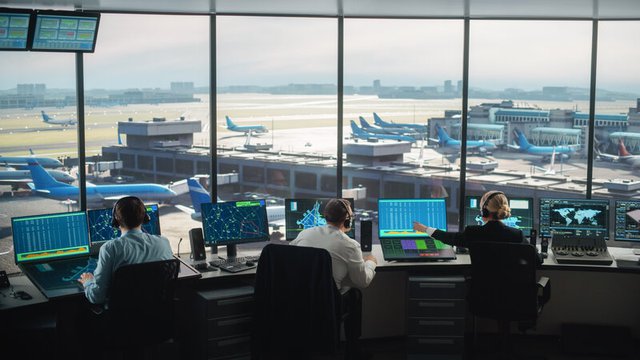

August is a time when many of us take a break from the daily routine and enjoy some well-earned rest and time to recharge our batteries. But as we fly off to far flung places in the world, and the airports experience a spike in the number of travellers, spare a thought for a key group of workers who will be busier than ever – air traffic controllers. They are the unsung heroes working behind the scenes to manage and coordinate the constant flow of planes in the airspace.
In this blog post, we will delve into the responsibilities of an air traffic controller, the significance of their role, and the steps you can take to pursue a rewarding career in this field, such as studying an Aerospace Engineering degree.
Air traffic controller definition
An air traffic controller is a trained professional responsible for providing instructions and guidance to pilots to ensure the safe take-off, landing, and en-route navigation of aircraft. These skilled individuals work in control towers and area control centres to maintain the orderly flow of air traffic. Their main objective is to prevent collisions and minimise delays while maintaining a high level of aviation safety.
Why are air traffic controllers so important?
The importance of air traffic controllers cannot be overstated. They act as the eyes and ears of the skies, monitoring radar displays and communication systems to keep track of aircraft in their designated airspace.
By managing aircraft movements efficiently, air traffic controllers help prevent potentially catastrophic accidents and maintain a smooth flow of air traffic, which is essential to avoid congestion and minimise flight delays, meaning we can all get to our destinations safely and on time.
Job description of an air traffic controller
Air traffic controllers have a diverse range of responsibilities that require split-second decision-making and unwavering focus. Some of the key tasks carried out by these professionals include:
- Providing clearances: Air traffic controllers issue take-off, landing, and taxi clearances to pilots while ensuring that runways and airspace are free from potential hazards.
- Separating aircraft: Ensuring safe distances between aircraft is paramount. Air traffic controllers calculate separation based on altitude, speed, and direction to prevent any mid-air collisions.
- Communicating with pilots: Controllers maintain constant communication with pilots, relaying weather updates, route changes, and instructions to ensure a smooth flight experience.
- Managing emergencies: In critical situations, air traffic controllers guide pilots during emergency landings and provide support in times of distress.
- Collaborating with other controllers: In complex airspaces where planes fly from one area to another controlled by a different aviation authority, controllers work as a team to hand off aircraft from one sector to another, ensuring a seamless transition in control.
Air traffic controller skills and qualities
Becoming an air traffic controller requires a unique set of skills, abilities, and characteristics, such as:
- Strong Communication Skills: Clear and concise communication is vital to convey instructions accurately and maintain seamless coordination with pilots.
- Stress Management: Air traffic controllers often work in high-pressure environments. The ability to stay calm and focused during intense situations is essential.
- Analytical Thinking: Controllers must analyse multiple sources of information simultaneously to make informed decisions quickly.
- Spatial Awareness: Understanding the position of aircraft in three-dimensional space is crucial for maintaining safe separation.
- Multi-Tasking: Handling several aircraft simultaneously requires efficient multi-tasking skills.
- Team Player: Collaboration with fellow controllers and aviation personnel is crucial for successful air traffic management.
What does it take to be an air traffic controller?
To embark on a career as an air traffic controller, aspiring candidates need to pursue specific educational and training paths. Each country has its own set of regulations in order to be a registered air traffic controller. A common route into the sector is to complete a degree in aviation, such as the one mentioned previously. These degrees cover topics such as aviation regulations, meteorology, navigation procedures, and air traffic control systems.
Following on from this, candidates apply to the aviation authorities and undertake specialised training. Candidates must pass rigorous aptitude tests, medical examinations, and background checks as part of the selection process.